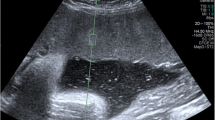Atomic force microscopy is not very popular in practical health care, therefore, its potential is not studied enough, for example, in obstetrics when studying the “mother—placenta—fetus” system. Our study summarizes the possibilities of using atomic force microscopy for detection of various circulatory disorders and vascular changes at the microscopic level in the uterus (endometrium and myometrium), placenta, and umbilical cord in the main variants of obstetric and endocrine pathology. For instance, in the case of endocrine pathologies, changes in the form of stasis, sludge, diapedesis, ischemia, destruction and separation of endotheliocytes in villous blood vessels were found in the mother. The oxygen content in erythrocytes also naturally decreased in pathologies; poikilo- and anisocytosis were observed.
Similar content being viewed by others
References
Dreval AV. Reproductive Endocrinology: Guidance for Physicians. Moscow, 2019. Russian.
Pavlova TV, Kulikovskii VF, Pavlova LL. Clinical and Experimental Morphology. Moscow, 2016. Russian.
Pavlova TV, Malyutina ES, Petrukhin VA. The mother–placenta–fetus system in diffuse toxic goiter: morphopathological aspects. Arkh. Patol. 2015;77(5):14-17. Russian.
Pavlova TV, Petrukhin VA, Malyutina ES, Kaplin AN, Zemlyanskaya LO. New information in the study of clinical and morphological aspects of endocrinopathies in pregnant women. Ross. Vestn. Akush.-Ginekol. 2020;20(5):13-20. Russian.
Pavlova TV, Petrukhin VA, Sumin SA, Selivanova AV, Syrtseva IS. Hemorheological features of uteroplacental blood flow in severe gestosis. Arkh. Patol. 2014;76(3):37-40. Russian.
Bobiński R, Pielesz A, Waksmańska W, Sarna E, Ulman-Włodarz I, Kania J, Mikulska M, Turbiarz A. Surface structure changes of pathological placenta tissue observed using scanning electron microscopy - a pilot study. Acta Biochim. Pol. 2017;64(3):533-535. doi: 10.18388/abp.2017_1528
Pavlova TV, Petruhin BA, Syrtseva IS, Selivanova AV, Markovskaya VA. Modern approaches to the study of erythrocytes of pre-eclampsia in the mother–placenta–fetus. J. Pharm. Res. 2017;11(12):1575-1578.
Scanning Microscopy for Nanotechnology: Techniques and Applications. Zhou W, Wang ZL, eds. Springer, 2007.
Author information
Authors and Affiliations
Corresponding author
Additional information
Translated from Byulleten’ Eksperimental’noi Biologii i Meditsiny, Vol. 171, No. 2, pp. 223-227, February, 2021
Rights and permissions
About this article
Cite this article
Pavlova, T.V., Shchegolev, A.I., Kaplin, A.N. et al. The Use of Atomic Force Microscopy in Comprehensive Assessment of the “Mother—Placenta—Fetus” System in Obstetric and Endocrine Pathology during Pregnancy. Bull Exp Biol Med 171, 254–257 (2021). https://doi.org/10.1007/s10517-021-05206-3
Received:
Published:
Issue Date:
DOI: https://doi.org/10.1007/s10517-021-05206-3




